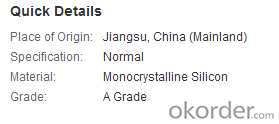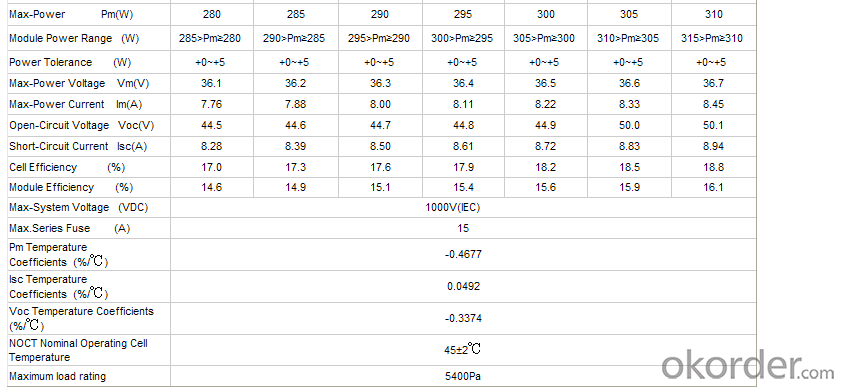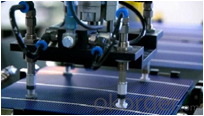300W Mono Solar Panels from CNBM with High Efficiency
- Loading Port:
- Shanghai
- Payment Terms:
- TT OR LC
- Min Order Qty:
- 1 pc
- Supply Capability:
- 99999999 pc/month
OKorder Service Pledge
OKorder Financial Service
You Might Also Like
Description:
CNBM Solar is a world-leading and Vertical integrated manufacturer ofhigh-performance with Silicon,
Wafer, Cells, Modules, which convertsunlight into electricity for residential, commercial, and utility-scale
power generation.
The capacity of CNBMSolar is reach to 1GW, andmake sure each year our shipment capacity is more
Than 700-800MWs, at the same time, wehave set up the largest solar power station with our partner
in Ukraine.
CNBM is a Quality + Service orientedcompany with“Excellence at Each Step” approach, composed of
the finest components from TUV andIEC-certified partners around the world, CNBM modules consistently
undergo a variety of trials at thecompany’s Test & Development Centre, ensuring peak performance
capabilities. The company iscommitted to develop and provide the world with clean and renewable energy
to ease the energy shortages as wellas human kind’s impact on the environment.





FAQ:What's your products warranty?
12yrs free from defects in materials and workmanship;No less than 90% within 10yrs and no less than 80% within 25yrs
- Q:What do these mean? I'm interested in doing a solar panel project. The problem is I know nothing about electricity, wiring, or panels so I've bought a small panel to experiment with first.I don't know what amps, watts, or volts are; what I should be reading on the batteries I will be charging? Or on the small appliances I will be running?The panel I bought has four settings:. 3V ---- 200mA2. 6V ---- 00 mA3. 9V ---- 50mA4. 2V ---- 50 mA(What is mA?)Also, will you give examples of what I can run with this? Make up any scenarios with whatever amps/volts/watts.
- mA means milliamps, i.e. 200 mA is the same thing as .2 amps. Amps refers to current and is the unit of measure for electrical current... Anyway, my point is, you are NOT going to be running ANY small appliance with a single solar cell. You might be able to run a small device that would normally run with a battery, but that is about all.
- Q:The average solar panel produces 0% of the energy that is put into it. What is happening to the other 90%? Is it being reflected or is it being obsorbed by materials that are not a part of the solar cell? Is it possible to one day have near 00% efficient solar cell technology?
- Sunlight comes in many frequencies, that's why it's white. Solar Photovoltaics require a photon to displace an electron from a semiconductor and that only happens at one frequency depending on what the semiconductor material is, therefore only one exact frequency gets turned into power. They are working on using organic dyes or quantum dots to absorb the energy in different frequencies and re-emit the energy in the desired frequency. They also are working on using multiple semiconductor materials to try and capture more frequencies. The rest of the energy becomes heat which also reduces the efficiency of the solar cells. The lab record for solar photovoltaics is 42.8% efficiency and quantum dots promises to be 65% to 75% efficient. Keep in mind that fossil fuels are based on energy collected by photosynthesis over millions of years. The efficiency of photosynthesis with modern plants is about 0.5% and the theoretical maximum efficiency of photosynthesis is 6.6%. All of our current energy use is based upon a small fraction of 0.5% efficiency over millions of years.
- Q:Can solar panels be used to power an emergency response center?
- Yes, solar panels can be used to power an emergency response center. Solar panels can generate electricity from sunlight, which can then be stored in batteries or directly used to power the center's equipment and infrastructure. This renewable energy source can provide a reliable and sustainable power supply, making an emergency response center less dependent on traditional energy sources during critical situations.
- Q:Can solar panels be used in areas with high levels of wildlife activity?
- Yes, solar panels can be used in areas with high levels of wildlife activity. While it is important to consider the impact on local wildlife, there are measures that can be taken to mitigate any potential negative effects. Proper installation, such as elevation and orientation, can reduce the likelihood of wildlife interference. Additionally, using appropriate barriers or deterrents can help protect the solar panels and prevent damage from animals. Overall, with proper planning and precautions, solar panels can be successfully utilized in areas with high levels of wildlife activity.
- Q:I have two solar panels that were going to be trashed at work. I want to use them to charge batteries on my RV but i noticed they put out around 20 volts in direct sunlight. So i am wondering: -isn't this way too much voltage for a 2 volt system? -do a need some sort of a regulator connected to keep them from overcharging?
- You okorder /
- Q:What is the principle of solar panels work?
- optical - electrical direct conversion method is the use of photoelectric effect, the solar radiation can be directly converted into electrical energy, optical - electrical conversion of the basic device is the solar cell. The solar cell is a device that converts solar energy directly into electrical energy due to the photovoltaic effect. It is a semiconductor photodiode. When the sun shines on the photodiode, the photodiode turns the solar energy into electricity. Current. When many batteries in series or in parallel can become a relatively large output power of the solar cell array
- Q:Are there any risks of fire associated with solar panels?
- Yes, there are certain risks of fire associated with solar panels, although they are relatively low compared to other energy sources. Potential causes of fire include electrical malfunctions, improper installation or maintenance, and damage from external factors such as lightning or extreme weather conditions. However, modern solar panel systems are designed with safety measures in place to minimize these risks, including fire-resistant materials and enhanced electrical protection. Regular inspections and adherence to installation guidelines can further reduce the chances of fire incidents.
- Q:Can cold light make solar panels power
- permanent, clean and flexible three major advantages of solar cells long life, as long as the sun exists, solar cells can be an investment and long-term use; compared with thermal power, Solar cells do not cause environmental pollution
- Q:Can solar panels be used in areas with high levels of insect activity?
- Yes, solar panels can be used in areas with high levels of insect activity. While insects may occasionally land on the surface of the panels, they do not pose a significant threat to the overall performance or lifespan of the system. Additionally, solar panels are designed to be durable and can withstand exposure to various environmental conditions, including insect activity.
- Q:Are there any fire hazards associated with solar panels?
- Yes, there are potential fire hazards associated with solar panels. Although solar panels themselves do not typically catch fire, electrical malfunctions or faults in the wiring, inverters, or connectors can lead to overheating and fire. Additionally, if a fire breaks out in the surrounding area, solar panels can hinder firefighting efforts by creating potential electrical hazards and obstructing access to the roof. Therefore, proper installation, regular maintenance, and compliance with fire safety regulations are crucial in mitigating these risks and ensuring the safe operation of solar panel systems.
1. Manufacturer Overview |
|
|---|---|
| Location | |
| Year Established | |
| Annual Output Value | |
| Main Markets | |
| Company Certifications | |
2. Manufacturer Certificates |
|
|---|---|
| a) Certification Name | |
| Range | |
| Reference | |
| Validity Period | |
3. Manufacturer Capability |
|
|---|---|
| a)Trade Capacity | |
| Nearest Port | |
| Export Percentage | |
| No.of Employees in Trade Department | |
| Language Spoken: | |
| b)Factory Information | |
| Factory Size: | |
| No. of Production Lines | |
| Contract Manufacturing | |
| Product Price Range | |
Send your message to us
300W Mono Solar Panels from CNBM with High Efficiency
- Loading Port:
- Shanghai
- Payment Terms:
- TT OR LC
- Min Order Qty:
- 1 pc
- Supply Capability:
- 99999999 pc/month
OKorder Service Pledge
OKorder Financial Service
Similar products
New products
Hot products
Related keywords






























